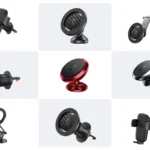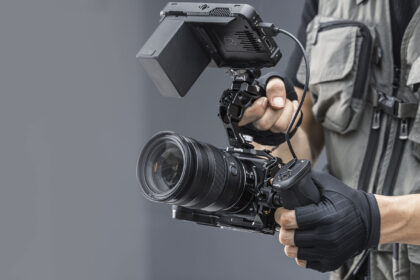Choosing the right stabilization tool is one of the most important decisions for filmmakers, especially if you’re new to shooting video or upgrading your gear. The debate of shoulder rig vs hand gimbal has become more relevant than ever as creators look for the perfect balance between cinematic movement, ease of use, and affordability. Both tools offer unique advantages, and the right choice ultimately depends on your filming style, camera setup, and the type of content you want to produce.
- What Is a Shoulder Rig? (Camera Shoulder Rig Explained)
- What Is a Hand Gimbal?
- Shoulder Rig vs Hand Gimbal: What’s the Main Difference?
- Shoulder Rig vs Hand Gimbal: Which Is Better for Filmmaking?
- Pros and Cons Comparison
- Cost Comparison: Shoulder Rig vs Hand Gimbal
- Do Professional Filmmakers Use Gimbals?
- Handheld vs Shoulder Rig
- Gimbal Shoulder Rig Hybrid Use Cases
- Which Should You Choose? (Beginner Recommendations)
- Best Accessories & Add-Ons to Enhance Stability
- FAQ (People Also Ask)
In this detailed guide, we’ll break down the differences between the two, compare performance, cost, and usability, and help you decide which stabilizer is ideal for your filmmaking needs.
What Is a Shoulder Rig? (Camera Shoulder Rig Explained)
A camera shoulder rig is a stabilizing support system designed to mount your camera and position it on your shoulder for steadier handheld shooting. It usually consists of:
- A shoulder pad
- Handles for grip
- Rods for attaching accessories
- A baseplate for your camera
- Optional counterweights, monitors, and microphones
Shoulder rigs are widely used in documentaries, interviews, ENG (Electronic News Gathering), short films, and run-and-gun productions.
Pros of Shoulder Rigs
- Great for long filming sessions
- More natural, organic handheld motion
- Supports heavier cinema cameras
- Lets you add accessories like follow focus, matte box, or external monitors
- No batteries required
Cons of Shoulder Rigs
- Heavier and bulkier than gimbals
- Requires practice for smooth movements
- Not ideal for highly dynamic or fast-moving shots
If you want a realistic, human-like camera feel or are shooting long takes, shoulder rigs are an excellent option.
What Is a Hand Gimbal?
A hand gimbal is a motorized stabilizer that uses 3-axis gyroscopic technology to keep your camera level and smooth even when you walk, run, or move rapidly. Modern gimbals are compact, lightweight, and beginner-friendly.
They are commonly used for cinematic travel videos, YouTube content, weddings, music videos, and commercial projects that require smooth, floating camera motion.
Pros of Gimbals
- Super smooth, cinematic stabilization
- Easy for beginners to master
- Lightweight and portable
- Perfect for dynamic and moving shots
- Great for mirrorless and DSLR cameras
Cons of Gimbals
- Battery-dependent
- Limited payload capacity
- Not ideal in tight spaces
- Some shots can feel too “robotic”
If your goal is buttery-smooth movement with minimal learning curve, gimbals are a strong choice.
Shoulder Rig vs Hand Gimbal: What’s the Main Difference?
The primary difference between a gimbal and a shoulder rig lies in the type of movement they produce.
| Feature | Shoulder Rig | Hand Gimbal |
|---|---|---|
| Movement Style | Natural, handheld | Smooth, mechanical |
| Stability Level | Medium to high | High to ultra-high |
| Weight | Heavy | Light |
| Power | No batteries needed | Requires batteries |
| Camera Compatibility | Works with heavy cameras | Limited to payload |
| Setup Time | Quick | Moderate |
| Best For | Documentary, interview, cinema | Travel, vlogging, dynamic shots |
A shoulder rig enhances the natural handheld look, while a gimbal gives you stabilized, floating movement.
Shoulder Rig vs Hand Gimbal: Which Is Better for Filmmaking?
The answer depends entirely on your shooting style.
- Choose a shoulder rig if you want realistic, handheld motion, a professional filmmaking look, or if you’re working with a heavier setup.
- Choose a hand gimbal if you need extremely smooth shots, are shooting run-and-gun with quick movements, or prefer a lightweight tool that’s easy to master.
Both stabilizers are excellent at what they do, but they serve different creative purposes.
Pros and Cons Comparison
Pros & Cons of Shoulder Rigs
Pros
- Realistic camera movement
- Ideal for long-duration filming
- Supports heavy cinema gear
- Accessory-friendly
- No batteries needed
Cons
- Bulky and heavy
- Requires operator skill
- Not suitable for highly dynamic shots
Pros & Cons of Hand Gimbals
Pros
- Ultra-smooth stabilization
- Beginner-friendly
- Lightweight, portable
- Great for moving shots
Cons
- Requires battery power
- Payload limitations
- May produce overly mechanical movement
Cost Comparison: Shoulder Rig vs Hand Gimbal
Cost is a major deciding factor for beginners and professionals alike.
Shoulder Rig Costs
You can find basic rigs at entry-level prices, but professional setups—especially with accessories—can increase the investment. The long-term cost tends to be lower since they don’t require batteries or frequent replacements.
Gimbal Costs
Gimbals vary from budget-friendly models to premium ones with higher payload capacity and advanced stabilization technology. However, gimbals come with added costs such as batteries, firmware updates, and the need for balanced setups.
Which Is More Cost-Effective?
- For cinematic handheld looks: Shoulder rig wins.
- For smooth dynamic motion: Gimbal wins.
It depends on the style of filmmaking you prioritize.
Do Professional Filmmakers Use Gimbals?
Yes, many professional filmmakers use gimbals—especially for action scenes, commercials, weddings, and music videos. Gimbals allow producers to capture smooth, stable footage without needing expensive Steadicam rigs.
However, for cinematic storytelling, dialogue scenes, or documentaries, many professionals still prefer shoulder rigs due to their natural movement and flexibility.
Professionals often combine both tools depending on the shot.
Handheld vs Shoulder Rig
Handheld shooting introduces micro-shakes that can look unprofessional unless used for stylistic purposes. A shoulder rig solves this by providing better stability while maintaining the handheld feel.
When Shoulder Rig Is Better:
- Longer shoots
- Natural, immersive camera work
- Heavy cinema cameras
When Handheld Works:
- Fast, chaotic, documentary-style shots
- When stabilization is not required
Gimbal Shoulder Rig Hybrid Use Cases
Some filmmakers use both: a gimbal for movement-heavy scenes and a shoulder rig for slower, more narrative-focused shots.
This hybrid method:
- Increases shot versatility
- Reduces fatigue when switching between shooting styles
- Helps create more dynamic sequences
If you want a complete filmmaking toolkit, owning both is ideal.
Which Should You Choose? (Beginner Recommendations)
Here’s a quick guide to help you decide:
Choose a Hand Gimbal If You Are:
- A YouTuber or vlogger
- A travel filmmaker
- Shooting weddings or events
- New to stabilization
- Using lightweight mirrorless cameras
Choose a Shoulder Rig If You Are:
- A documentary filmmaker
- Shooting interviews or short films
- Using heavy DSLR or cinema cameras
- Wanting a natural handheld feel
- Filming long takes
If you can afford both, your filmmaking versatility increases significantly.
Best Accessories & Add-Ons to Enhance Stability
Accessories can improve comfort, stability, and shooting performance.
For Shoulder Rigs:
- Counterweights
- Handles and grips
- Quick-release plates
- Follow focus
- Shoulder pads
For Gimbals:
- External monitor
- Dual-handle grip
- Gimbal arm support
- Cage for better balance
For more mounting options and accessories, you can explore tools at cameraholder.com to enhance your stabilizer setup.
FAQ (People Also Ask)
What is the difference between a gimbal and a shoulder rig?
A gimbal uses motorized stabilization for smooth, floating shots, while a shoulder rig stabilizes footage through your body’s natural balance, creating a more handheld look.
Is a shoulder rig better than a gimbal?
A shoulder rig is better for long takes and cinema-style handheld shots. A gimbal is better for ultra-smooth, dynamic motion.
Do I need both a shoulder rig and a gimbal?
If you shoot different types of films, owning both gives you full versatility.
What is a camera shoulder rig used for?
It supports long-duration filming, adds stability, and is ideal for documentaries, interviews, and narrative filmmaking.
Is handheld better than shoulder rig?
A shoulder rig provides more control and reduces shake compared to pure handheld shooting.
Are gimbals good for filmmaking?
Yes, gimbals are excellent for cinematic smoothness, moving shots, and beginner-friendly stabilization.




